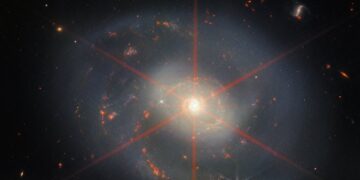Active galactic nuclei (AGN) are among the universe’s brightest and most enigmatic phenomena. Powered by supermassive black holes (SMBHs) accreting matter, these cosmic powerhouses emit dazzling radiation that often outshines their entire host galaxies. At the heart of this brilliance lies the broad-line region (BLR), a dynamic and mysterious zone of ionized gas producing distinctive emission lines.
What Are AGN and Broad-Line Regions?
AGN are luminous regions surrounding SMBHs, fueled by the intense accretion of matter. Within these regions, the BLR is a critical component, located near the SMBH. This zone of high-velocity ionized gas produces broad emission lines in ultraviolet and optical spectra.
These lines, often exceeding widths of 1,000 km/s, are the result of photoionization processes driven by radiation from the accretion disk. Understanding the BLR’s structure and motion is key to probing the physical processes within AGN and accurately estimating SMBH masses.
NGC 4151: A Changing-Look AGN in Focus
NGC 4151, often referred to as a “changing-look” AGN, has long been a focal point for astrophysical research. Changing-look AGN are unique due to their dramatic luminosity fluctuations, which can reveal transformative changes in their BLRs.
Dr. Feng’s four-year reverberation mapping campaign of NGC 4151, conducted at the Lijiang Observatory, offered a rare opportunity to study these variations during the AGN’s outburst phase. The findings highlight how changes in brightness can significantly alter BLR properties.
The Anti-Breathing Effect: A Puzzling Phenomenon
One of the study’s most intriguing discoveries is the “anti-breathing effect” observed in NGC 4151. Conventional models predict that an increase in AGN luminosity causes the BLR radius to expand, leading to longer time delays in broad emission lines—a behavior known as the “breathing effect.” However, observations revealed the opposite: as NGC 4151 brightened, the time delays shortened.
This anti-breathing effect suggests a more complex interplay between the AGN’s luminosity and BLR geometry, potentially linked to time delays between ultraviolet and optical continuum variations.
Stratification Within the BLR
The research also uncovered stratification within the BLR of NGC 4151, with distinct emission lines originating from specific radial regions. This stratification reflects variations in ionization levels and density across the BLR, offering new insights into the region’s physical and kinematic properties.
Understanding these layers is crucial for developing accurate models of BLR dynamics and their relationship with SMBHs.
Rapid Changes in BLR Geometry and Kinematics
Perhaps the most surprising aspect of the study is the rapid evolution of the BLR’s geometry and motion, observed on timescales of less than a year. These changes cannot be fully explained by simple variations in gas distribution, radiation pressure, or ionizing radiation.
Instead, the findings suggest a complex interplay of multiple mechanisms influencing the BLR’s behavior. This revelation challenges long-standing assumptions and underscores the need for more nuanced models of AGN and BLR dynamics.
Implications for AGN and SMBH Research
The findings from NGC 4151 have far-reaching implications for astrophysics. By providing a detailed view of BLR behavior, the study enhances our ability to measure SMBH masses and understand AGN luminosity variations.
Moreover, it sheds light on the broader role of AGN in galaxy evolution and cosmic dynamics. As AGN are thought to regulate star formation and influence their host galaxies, understanding their inner workings is critical for a comprehensive view of the universe.
Future Research Directions
This groundbreaking study is just the beginning. Future research will likely focus on extending reverberation mapping campaigns to other AGN, exploring how BLR dynamics vary across different luminosity states.
Advanced telescopes and computational models will play a crucial role in uncovering more details about BLRs and their interactions with SMBHs. These efforts will not only refine our understanding of AGN but also open new windows into the universe’s most luminous and mysterious phenomena.
Conclusion: A New Chapter in Cosmic Understanding
The study of the BLR in NGC 4151 marks a significant milestone in astrophysics. By revealing the complex and dynamic nature of this region, researchers have challenged existing theories and paved the way for new discoveries. As we continue to explore the cosmos, the insights gained from AGN and their BLRs will undoubtedly deepen our understanding of the universe and our place within it



















